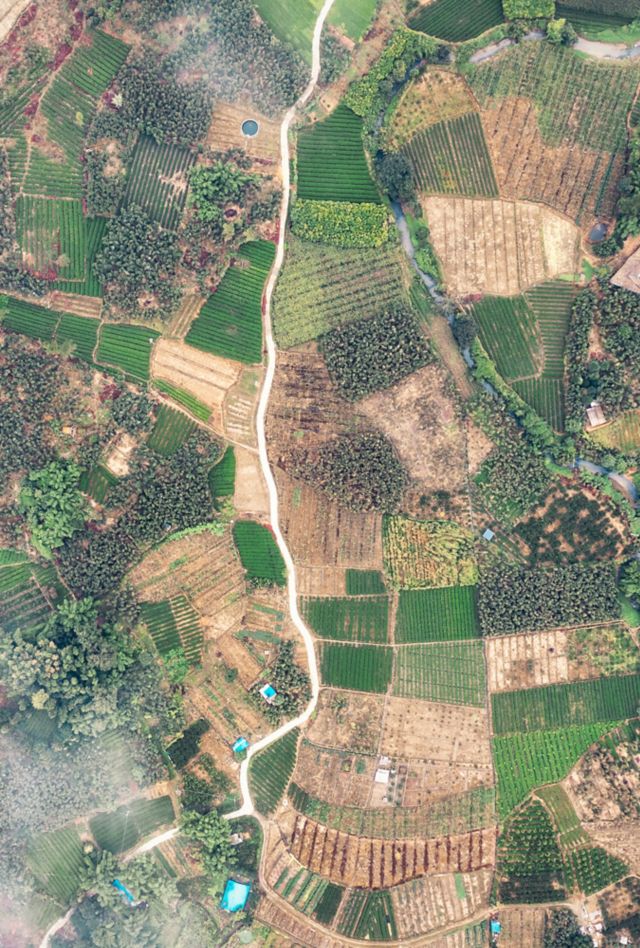How NORC Developed a More Accurate & Affordable Survey Sampling Method Using Satellite Imagery

Authors
Lee Fiorio
May 2025
NORC has developed a process that enhances residential address lists from the USPS, improving the potential inclusion of rural, low-income, and high-growth areas in surveys.
Producing high-quality surveys requires high-quality sampling frames. Because many surveys today rely on address frames to support multiple modes of contact like mail, phone, and face-to-face interviewing, comprehensive address frames are more important than ever.
In 2020, NORC methodologists developed a process for enhancing residential address lists from the United States Postal Service (USPS) with data from a combination of sources, including satellite imagery, building footprint maps, and property records. NORC’s method uses digital mapping tools to overlay and integrate data from these multiple sources to enhance the coverage of address frames, thereby improving the potential inclusion of rural, low-income, or high-growth areas in NORC surveys. This innovation has improved the accuracy and cost-effectiveness of address frame construction across NORC projects.
NORC has been a leader in address frame development.
NORC has long led the industry in address frame development and was an early adopter of licensed versions of the USPS Computerized Delivery Sequence File (CDS) for address-based samples. Before the early 2000s, surveys that required address frames for sampling would source their addresses directly from the field through a process known as listing or address canvassing. This kind of field effort was labor-intensive and costly.
Research by NORC methodologists in the early 2000s demonstrated that address lists could be sourced from the CDS, reducing costs and improving address list quality relative to address canvassing. However, the CDS never completely replaced the need for field enhancement. In some places, particularly rural, low-income, or high-growth areas, CDS address lists are patchy and incomplete and need enhancement. To illustrate, of the 1,514 areas selected for the 2010 NORC National Frame, 123 (8 percent) were visited and listed by NORC field staff to ensure complete address coverage.
Figure 1
This stylized view shows tax parcels (yellow polygons) and geocoded CDS address points (purple dots) overlaid on aerial imagery. NORC reviewed areas with low CDS coverage and identified the tax parcels corresponding to housing units missing from the CDS.

Enhancing address lists with satellite imagery and property records improves coverage at a relatively low cost.
In preparation for developing the 2020 NORC National Frame, methodologists at NORC began testing whether in-person address canvassing could be replaced with alternative approaches that use remote sensing data and administrative records. The idea was simple—instead of sending field staff to areas with low CDS coverage to find and list missing addresses, could we find and list those missing addresses using satellite imagery and property records?
Results from two validation experiments demonstrated the benefit of this “remote listing” approach. Field staff visited 13 areas where address lists had been enhanced using the remote listing process and confirmed the addresses supplemented from property records at the same rate as addresses sourced directly from the CDS. Although field staff identified some missing addresses, the remote listing method produced high-quality address lists across various areas with otherwise low CDS coverage.
In total, NORC used in-office listing to enhance the CDS in 60 areas in the 2020 NORC National Frame, improving the coverage from 38 percent to 98 percent (relative to the 2020 Census total housing unit count).
Developing a remote address listing procedure required innovations in data linkages and interactive web mapping.
Developing a remote listing process required NORC to develop several innovations. First, to reduce the risk of producing lists with duplicate addresses, we needed to identify a strategy for linking and synthesizing information across different data types: building footprint data, tax parcel boundaries, CDS address strings, and point locations, as well as address strings from property records. Our approach entailed a novel combination of spatial joins on geographic features and record linkages on cleaned and standardized address strings.
Second, we needed to create an interactive web mapping platform that staff performing the remote listing could use to review property records and select addresses representing those missing from the CDS. For this purpose, we developed a dashboard web app in R Shiny and JavaScript that displayed tables and maps and allowed listers to carefully review housing units over the full spatial extent of the target area.
The benefits of remote listing go beyond improving address frame coverage.
Although the CDS is continuously improving, there remains a need for methods that enhance CDS address lists in places where they fall short of adequate coverage. NORC’s recent innovations in integrating property records and satellite imagery have resulted in a more cost-effective approach for enhancing CDS-based address lists, improving sample coverage across NORC surveys. However, this remote listing approach has benefits beyond improving address-list coverage for surveys and extending to NORC’s recent efforts to help improve the accuracy of U.S. Census Bureau estimates.
Further research should continue to explore integrating different kinds of address and housing unit information to improve survey accuracy and reduce respondent burden. As the use of administrative records in survey research continues to grow, synthesizing and maintaining data at the address level will be an important part of ensuring quality in survey populations and study designs.
References
Amaya, Ashley, Felicia LeClere, Lee Fiorio and Ned English. Improving the Utility of the DSF Address-Based Frame through Ancillary Information. Field Methods. 2014 26: 70.
Eckman, S and English, N. 2012. Creating Housing Unit Frames from Address Databases: Geocoding Precision and Net Coverage Rates. Field Methods. 24(4): 399-408 http://fmx.sagepub.com/content/early/2012/07/02/1525822X12445141.abstract?papetoc
English, Ned, Colm O’Muircheartaigh, Michael Latterner, Stephanie Eckman, and Katie Dekker. Modeling the Need for Traditional vs. Commercially Available Address Listings for In-Person Surveys: Results from a National Validation of Addresses (Summary). Survey Practice, June 2009.
Fiorio, Lee, Chang Zhao, Peter Herman, and Ned English. Using an Interactive Mapping Dashboard to Conduct In-Office Housing Unit Listing using County Assessor Tax Parcel Data. Presented at the American Association for Public Opinion Research Conference, Chicago, May 2022.
Fiorio, Lee, Chang Zhao, Peter Herman, and Ned English. Address Frame Enhancement with Administrative Data using an Interactive Mapping Dashboard. Presented at the Federal Committee on Statistical Methodology Conference. Washington, DC, October 2022.
Montaquila, Jill, Valerie Hsu, J. Michael Brick, Ned English, and Colm O'Muircheartaigh. A Comparative Evaluation of Traditional Listing vs. Address-Based Sampling Frames: Matching with Field Investigation of Discrepancies. 2009 Proceedings of the American Statistical Association, Survey Research Methods Section [CD ROM], Alexandria, VA: American Statistical Association.
Fiorio, L., (2024, August 28). Ensuring Fair Representation for Cities and States through Accurate Census Data. [Web blog post]. NORC at the University of Chicago. Retrieved from https://www.norc.org.
Fiorio, Lee, and Ned English. Accurately Identifying and Enumerating Multiunit Housing with Remote Sensing Data for Address Frame Enhancement. Presented at the Federal Committee on Statistical Methodology Conference. Washington, DC, October 2023.
O’Muircheartaigh, Colm, Stephanie Eckman, and Charlene Weiss. "Traditional and enhanced field listing for probability sampling." In Proceedings of the American Statistical Association Social Statistics Section, pp. 2563-7. 2002.
O'Muircheartaigh, Colm, Stephanie Eckman, Ned English, James Lepkowski, and Steven Heeringa. Comparison of Traditional Listings and USPS Address Database as a Frame for National Area Probability Samples. Presented At American Association for Public Opinion Research Conference, May 2005, Miami Beach, FL.
O’Muircheartaigh, Colm, Ned English, Stephanie Eckman, Heidi Upchurch, Erika Garcia Lopez, and James Lepkowski. Validating a Sampling Revolution: Benchmarking Address Lists Against Traditional Field Listing. 2006 Proceedings of the American Statistical Association, AAPOR Survey Research Methods Section [CD ROM], Alexandria, VA: American Statistical Association.
O’Muircheartaigh, Colm and Ned English. The Trajectory of the USPS DSF: Change in National Coverage for In-Person Interviewing 2000-2010. Presented at the American Association for Public Opinion Research Conference, May 2013, Boston, MA.
Suggested Citation
English, N. & Fiorio, L. (2025, May 19). How NORC Developed a More Accurate & Affordable Survey Sampling Method Using Satellite Imagery. Retrieved from https://www.norc.org.







